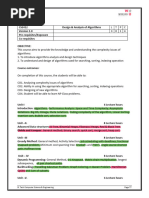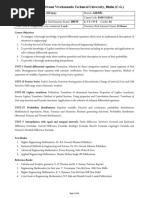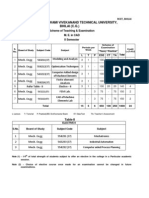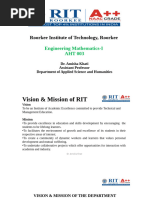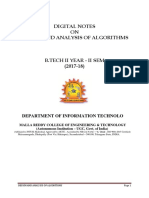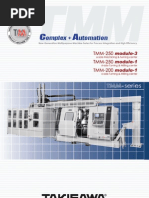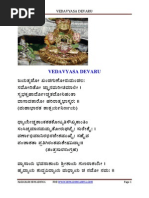DAA Syllabus
DAA Syllabus
Uploaded by
bhaimodel20Copyright:
Available Formats
DAA Syllabus
DAA Syllabus
Uploaded by
bhaimodel20Copyright
Available Formats
Share this document
Did you find this document useful?
Is this content inappropriate?
Copyright:
Available Formats
DAA Syllabus
DAA Syllabus
Uploaded by
bhaimodel20Copyright:
Available Formats
B.
Tech CSE AR22
GEETHANJALI COLLEGE OF ENGINEERING AND TECHNOLOGY
(UGC Autonomous)
Cheeryal (V), Keesara (M), Medchal Dist., Telangana-501301
20CS22001-DESIGN AND ANALYSIS OF ALGORITHMS
B.Tech. CSE - II Year, II Sem.
L T P/D C
Prerequisite(s): 3 - -/- 3
20CS12002-DISCRETE MATHEMATICS
20CS21001-DATA STRUCTURES
Course Objectives
Develop ability to
1. Learn the asymptotic notations and understand the performance of algorithms.
2. Learn the behavior of Greedy strategy, Divide and Conquer approach, Dynamic
3. Programming and branch and bound theory and apply them for several problem
solving techniques.
4. Explore various data structures and algorithm design methods together impacts the
performance of programs.
5. Distinguish between deterministic and non-deterministic algorithms and their
computational efficiency.
Course Outcomes (COs)
After completion of the course, student would be able to
CO1. Analyze time and space complexity of a given algorithm and use asymptotic
notation to represent the complexities.
CO2. Apply divide and conquer, greedy, dynamic programming, backtracking and
branch and bound algorithmic approaches to a given problem.
CO3. Prove that a given problem is NP-Complete by using the concepts of NP-
Completeness.
UNIT-I
INTRODUCTION: Algorithm, Pseudo code for expressing algorithms, Performance
analysis, Time complexity and space complexity, Asymptotic Notations: O notation, Omega
notation, theta notation, and little o notation.
DIVIDE AND CONQUER: General method, applications – binary search, merge sort, quick
sort, Strassen‟s matrix multiplication.
UNIT-II
SEARCHING AND TRAVERSAL TECHNIQUES : Efficient non-recursive binary tree
traversal algorithms, spanning trees, graph traversals- BFS and DFS, Connected components,
bi-Connected components.
Disjoint sets: operations, union and find algorithms.
UNIT-III
GREEDY-METHOD: General method, Applications-Job sequencing with deadlines, 0/1
knapsack problem, minimum cost spanning tree, single source shortest path problem.
DYNAMIC PROGRAMMING: General method, applications-multistage graphs, matrix
chain multiplication, optimal binary search trees, 0 /1 knapsack problem, travelling sales
person problem, reliability design problem.
Department of Computer Science and Engineering 97
B.Tech CSE AR22
UNIT-IV
BACK TRACKING: General method, applications: n-queens problem, sum of sub set
problem, graph colouring problem, Hamiltonian cycles.
BRANCH and BOUND: General method, applications: Job Sequencing with deadlines,
travelling sales person problem, 0 /1 knapsack problem, LC branch and bound, FIFO branch
and bound solution.
UNIT-V
NP-Hard and NP-Complete problems: Basic concepts, non deterministic algorithms, NP-
hard and NP- complete classes, NP- Hard problems, Cook‟s theorem.
TEXT BOOK(S)
1. Fundamentals of Computer Algorithms Ellis Horowitz, Satraj Sahni and Sanguthevar
Rajasekharan, 2 nd Edition, Universities Press, 2009 Reprint.
2. Introduction to Algorithms, secondediton, T.H.Cormen, C.E.Leiserson, R.L.Rivest,
and C.Stein, PHI Pvt.Ltd/Person Education.
REFERENCE BOOK(S)
1. Design and Analysis of Algorithms, Aho, Ullman and Hopcroft, Pearson education,
Reprint 2004.
2. Introduction to Design and Analysis of Algorithms A strategic approach, R.C.T.Lee,
S.S.Tseng, R.C.Chang and T.Tsai, Mc.Graw Hill
3. Data structures and Algorithm Analysis in C++, Allen Weiss, Second edition, Perason
education
4. Algorithms-Richard Johnson baugh and Marcus Schaefer, Pearson Education
5. Design and Analysis Algorithms-Parag Himanshu Dave, Himanshu Bhalachndra
Dave Publisher: Person
6. Algorithm Design: Foundations, Analysis and Internet examples, M.T.Goodrich and
R.Tomassia, John wiley and sons.
Department of Computer Science and Engineering 98
You might also like
- Uptu B.tech 2nd Year SyllabusDocument16 pagesUptu B.tech 2nd Year SyllabusPrakash KumarNo ratings yet
- Design and Analysis of AlgorithmsDocument2 pagesDesign and Analysis of AlgorithmsLOKESWARI GNo ratings yet
- 9.DAA R18 SyllabusDocument2 pages9.DAA R18 Syllabusanitha christopherNo ratings yet
- AdA SyllabusDocument1 pageAdA SyllabusKore RameshNo ratings yet
- DAA SyllabusDocument2 pagesDAA Syllabussushankreddy0712No ratings yet
- Discrete SyllabusDocument2 pagesDiscrete SyllabusRithik 56No ratings yet
- Jawaharlal Nehru Technological University Anantapur: (9A05403) Design and Analysis of AlgorithmsDocument2 pagesJawaharlal Nehru Technological University Anantapur: (9A05403) Design and Analysis of AlgorithmsY David Abhishek RajNo ratings yet
- Discrete StructuresDocument3 pagesDiscrete StructuresVamsi VersatileNo ratings yet
- MR22 3-1 and 3-2Document68 pagesMR22 3-1 and 3-2write2pranathiNo ratings yet
- B.tech Cse III Sem Syllabus Hyd CampusDocument10 pagesB.tech Cse III Sem Syllabus Hyd Campussunshinecreations14388No ratings yet
- III Sem Syllabus 2021-22270921011201Document13 pagesIII Sem Syllabus 2021-22270921011201xyush207No ratings yet
- Advanced Algorithms - Cse-CsDocument2 pagesAdvanced Algorithms - Cse-Csaarthi devNo ratings yet
- II-I Final SYLLABUS OF CSE (AI&ML) - 2Document20 pagesII-I Final SYLLABUS OF CSE (AI&ML) - 2Syed SameerNo ratings yet
- Network Engineering 05 It 60xxDocument62 pagesNetwork Engineering 05 It 60xxwhiteelephant93No ratings yet
- Cse Ucev Ug Ata FinalDocument112 pagesCse Ucev Ug Ata FinalSneha SruthiNo ratings yet
- Fourier Series: Fourier Series For Continuous & Discontinuous Functions, Expansion ofDocument17 pagesFourier Series: Fourier Series For Continuous & Discontinuous Functions, Expansion ofRavi VermaNo ratings yet
- DAA SYLLABUSDocument2 pagesDAA SYLLABUSprabhu.nandhikolaNo ratings yet
- Daa SyllabusDocument2 pagesDaa Syllabushashitapusapati012No ratings yet
- Original 1676265125 DAA SyllabusDocument2 pagesOriginal 1676265125 DAA SyllabusVignesh Devamulla100% (1)
- DAA SyllabusDocument2 pagesDAA SyllabusLalithya TumuluriNo ratings yet
- Department of Computer Engineering: Third Year B. Tech SyllabusDocument3 pagesDepartment of Computer Engineering: Third Year B. Tech Syllabuspranali suryawanshiNo ratings yet
- 2017_mc_syllabus_removedDocument3 pages2017_mc_syllabus_removedDivyam BaukhandiNo ratings yet
- 3rd Sem SyllabusDocument24 pages3rd Sem Syllabusgoelh6718No ratings yet
- B.tech IT Syllabus 2017 RegulationDocument12 pagesB.tech IT Syllabus 2017 RegulationNandha KumarNo ratings yet
- Syllabus Iot Second YearDocument10 pagesSyllabus Iot Second YearShubh GuptaNo ratings yet
- Kerala Technological University: Master of TechnologyDocument69 pagesKerala Technological University: Master of TechnologyREVATHY RATHEESHNo ratings yet
- Meol1 Operations Research: L T P C Int Ext 2 1 - 3 30 70 Open Elective - M.E. Course ObjectivesDocument2 pagesMeol1 Operations Research: L T P C Int Ext 2 1 - 3 30 70 Open Elective - M.E. Course ObjectivesThrinadhNo ratings yet
- Syllabus II and IV SemDocument21 pagesSyllabus II and IV Semao7186220No ratings yet
- Scheme & Syllabus III & IV Semester B.E Computer Science and Engineering (2012 Scheme)Document46 pagesScheme & Syllabus III & IV Semester B.E Computer Science and Engineering (2012 Scheme)Lalit KumarNo ratings yet
- 2nd Sem Syllabus NimcetDocument14 pages2nd Sem Syllabus NimcetPalak SinghNo ratings yet
- CSE_3-2-Sem-_CS-Syllabus_UG_R20-Revised-on-27-02-2023Document5 pagesCSE_3-2-Sem-_CS-Syllabus_UG_R20-Revised-on-27-02-2023csecgirls0203No ratings yet
- 7th SEM - SYLLABUS OF INSTITUTE ELECTIVE PDFDocument71 pages7th SEM - SYLLABUS OF INSTITUTE ELECTIVE PDFVinay RajuNo ratings yet
- ADS SyallabusDocument2 pagesADS SyallabusviksonioNo ratings yet
- Department of Computer Science and EngineeringDocument40 pagesDepartment of Computer Science and EngineeringManikandan SubbarajaNo ratings yet
- AIML S3 SyllabusDocument14 pagesAIML S3 Syllabusitscrazyboy.13No ratings yet
- BTech Computer Science SyllabusDocument28 pagesBTech Computer Science SyllabusRohit SharmaNo ratings yet
- Iind Sem Me (Cad) Rcet - BhilaiDocument10 pagesIind Sem Me (Cad) Rcet - BhilaiMohammed Abu SufianNo ratings yet
- B.Tech. CSE Syllabus 3rd-4thDocument26 pagesB.Tech. CSE Syllabus 3rd-4thMd Shaad AhamedNo ratings yet
- 3 Sem DMS SyllabusDocument2 pages3 Sem DMS SyllabusSanthosh Y MNo ratings yet
- Syllabus Content B.Tech CSE 3rd Sem Common To All SpecializationDocument10 pagesSyllabus Content B.Tech CSE 3rd Sem Common To All SpecializationwhatsappbackupdevNo ratings yet
- Btech Cse 3 SEMDocument88 pagesBtech Cse 3 SEMDevil EvilNo ratings yet
- Syllabus 4th CseDocument10 pagesSyllabus 4th CseAbubakar QuadriNo ratings yet
- BCA SEM I Syllabus NEP 20Document8 pagesBCA SEM I Syllabus NEP 20mungalsneha6604No ratings yet
- Data Structures: Course Code: 13CT1106 L TPC 4 0 0 3Document3 pagesData Structures: Course Code: 13CT1106 L TPC 4 0 0 3Akshay ShindeNo ratings yet
- CSE CompleteDocument126 pagesCSE CompleteSameer ChandraNo ratings yet
- I. M.sc. Maths & Computing Syllabus AR 2018Document122 pagesI. M.sc. Maths & Computing Syllabus AR 2018Preetam KumarNo ratings yet
- Amisha KhatiDocument20 pagesAmisha Khatiakashjaiswal.eceNo ratings yet
- HO Jan23 Sem Syllabus MCADocument19 pagesHO Jan23 Sem Syllabus MCADileep K RNo ratings yet
- ADocument8 pagesArec6718No ratings yet
- M.tech Vjti Extc SyllabusDocument52 pagesM.tech Vjti Extc SyllabusPravin SalunkheNo ratings yet
- Revised Scheme & Syllabus of The MCA ProgrammeDocument37 pagesRevised Scheme & Syllabus of The MCA ProgrammeDeepthi BipinNo ratings yet
- CSE SyallbusDocument126 pagesCSE SyallbusAjay KumarNo ratings yet
- CSEN3001 SyllabusDocument2 pagesCSEN3001 SyllabusAjitesh SinghNo ratings yet
- 3rd SBSNKDocument11 pages3rd SBSNKaadityapatni57No ratings yet
- 3rd Sem SyllabusDocument7 pages3rd Sem Syllabusyushiro.denkaiNo ratings yet
- Design and Analysis of AlgorithmDocument116 pagesDesign and Analysis of AlgorithmKunal JanjiralaNo ratings yet
- Computational Geometry: Exploring Geometric Insights for Computer VisionFrom EverandComputational Geometry: Exploring Geometric Insights for Computer VisionNo ratings yet
- Models and Analysis for Distributed SystemsFrom EverandModels and Analysis for Distributed SystemsSerge HaddadNo ratings yet
- 2N5951 N-Channel RF Amplifier: Absolute Maximum RatingsDocument3 pages2N5951 N-Channel RF Amplifier: Absolute Maximum RatingsMarving Velásquez RivasNo ratings yet
- Module 2Document25 pagesModule 2stevenvillastique9No ratings yet
- Research Article: Synthesis and Analgesic Activity of Novel Derivatives of 1,2-Substituted BenzimidazolesDocument7 pagesResearch Article: Synthesis and Analgesic Activity of Novel Derivatives of 1,2-Substituted BenzimidazolesRahul B SNo ratings yet
- Process CostingDocument48 pagesProcess CostingIrfanNo ratings yet
- Working of Single Plate ClutchDocument1 pageWorking of Single Plate ClutchBikash Das50% (2)
- ANDERSON - AI806-2700VV07i70 A (7-9 Dbi)Document1 pageANDERSON - AI806-2700VV07i70 A (7-9 Dbi)Yord JaNo ratings yet
- Case 6 - Mikhak Fresh Cut FlowersDocument5 pagesCase 6 - Mikhak Fresh Cut FlowersENRICH YOUR ENGLISHNo ratings yet
- Bloodborne Chalice Dungeon List PDFDocument4 pagesBloodborne Chalice Dungeon List PDFJoão PricinattoNo ratings yet
- Case Study - Sealless Pumps For Schwarz PharmaDocument1 pageCase Study - Sealless Pumps For Schwarz PharmaTasawwur TahirNo ratings yet
- Mood PsychologyDocument6 pagesMood PsychologyScribdTranslationsNo ratings yet
- NDT - Penetration Testing Level2Document1 pageNDT - Penetration Testing Level2davidNo ratings yet
- 15 FY9FE Basic Science QP PDFDocument10 pages15 FY9FE Basic Science QP PDFpriya raju100% (1)
- The Anatomy, Histology and Development of The Stomach PDFDocument7 pagesThe Anatomy, Histology and Development of The Stomach PDFredderdatNo ratings yet
- Screening For Polypropylene Degradation Potential 2Document11 pagesScreening For Polypropylene Degradation Potential 2Nor Ismaliza Mohd IsmailNo ratings yet
- The Factories Act, 1965 - 230918 - 112659Document124 pagesThe Factories Act, 1965 - 230918 - 112659rahman2011018No ratings yet
- Jurnal MikrobiologiDocument8 pagesJurnal MikrobiologiDwitaRiadiniNo ratings yet
- C17 Worksheet Week2+Document2 pagesC17 Worksheet Week2+Hussam AgabNo ratings yet
- NST110, Toxicology Department of Nutritional Sciences and Toxicology University of California, BerkeleyDocument29 pagesNST110, Toxicology Department of Nutritional Sciences and Toxicology University of California, BerkeleyAitheng Lum100% (1)
- TAKISAWA TMM-series (E) 2009-11Document17 pagesTAKISAWA TMM-series (E) 2009-11UNIVERSALCNCNo ratings yet
- CYW954907AEVAL1F Evaluation Kit User Guide PDFDocument67 pagesCYW954907AEVAL1F Evaluation Kit User Guide PDFRamon Jaramillo MartinezNo ratings yet
- STB 111 (2011)Document26 pagesSTB 111 (2011)Balarabe EL-Hussain40% (5)
- Keep Up With Ladder Safety (EN and SP)Document2 pagesKeep Up With Ladder Safety (EN and SP)pruncu.alianmNo ratings yet
- Surface Area and Volume PDFDocument3 pagesSurface Area and Volume PDFQSQFNo ratings yet
- Dell Powerconnect 5548 Users GuideDocument728 pagesDell Powerconnect 5548 Users Guidesmash2006No ratings yet
- Batteries Cell Phones IEEE1725Document3 pagesBatteries Cell Phones IEEE1725Irving LeepackNo ratings yet
- rrb alp ??Document29 pagesrrb alp ??Konda RanjithNo ratings yet
- Top 164 Calculus Pyqs of Jee Mains (2022-2024) ChapterwiseDocument22 pagesTop 164 Calculus Pyqs of Jee Mains (2022-2024) ChapterwiseNisargNo ratings yet
- Pakistan Petroleum: Discovery of Gas Well Jhim East X-1, in Block 2467-16 Bandar)Document1 pagePakistan Petroleum: Discovery of Gas Well Jhim East X-1, in Block 2467-16 Bandar)Mohammad RazaNo ratings yet
- Comparison of LMS and Neural NetworkDocument42 pagesComparison of LMS and Neural NetworkarundhupamNo ratings yet
- Vedavyasa DevaruDocument7 pagesVedavyasa DevarunaraharisumadhwaNo ratings yet



















